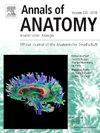Sex determination in German Mast geese (Anser anser) with 3D modeling pelvimetry examination
IF 2
3区 医学
Q2 ANATOMY & MORPHOLOGY
引用次数: 0
Abstract
Background
The avian pelvis is known to differ in shape between males and females due to the need for females to lay eggs, with egg shape correlating to pelvic shape. Geese breeding is done as an alternative to the poultry sector in our country for meat and, to a lesser extent, eggs. However, in recent years, there has been an increase in the number of those who are breeding geese as large enterprises. Understanding the anatomical structure of geese is essential. With 3D-modeling studies the use of artificial intelligence has increased and thus artificial intelligence has taken its place in the definition of anatomical structures. Accordingly, this study was conducted to determine the sexual dimorphism of this species by determining the three-dimensional pelvimetric data of the pelvic region of German Mast geese by gender, and also to provide reference data for zooarchaeology, taxonomy, obstetrics, and gynecology studies.
Materials and methods
In our study, 40 (20 female and 20 male) adult (1.5–2 years old) German Mast geese were used. Adult males weighed an average of 9.0 kg, while females weighed around 8.0 kg. Computerized tomography images were converted into 3D. Measurement points were determined, and morphometric measurements were taken. Subsequently, the statistical analysis of the obtained measurement values was performed.
Results
In Table 1, L1, L2, L3, L3, L5, L6, L8, L8, L9, L10, L11 and A1 measurement parameters of the pelvis showed that males were larger than females. L4, RA2, and LA2 measurement parameters showed that females were larger than males. L1, L2, and L9 measurement points were statistically significant (P < 0.05).
Conclusion
The results of this study can be taken as a reference in the evaluation of CT images of this species and can be used in various obstetric and gynecological diseases and in studies in the field of zooarchaeology and forensic sciences. In addition, 3D-models obtained using cross-sectional imaging devices can be helpful in the education of the anatomy of this species.
用三维建模骨盆测定法测定德国大雁的性别
鸟类骨盆的形状在雄性和雌性之间是不同的,因为雌性需要产卵,而卵子的形状与骨盆的形状相关。在我国,鹅的饲养是作为禽肉的替代品,在较小程度上,是鸡蛋的替代品。然而,近年来,作为大型企业的种鹅数量有所增加。了解鹅的解剖结构是必不可少的。随着3d建模的研究,人工智能的使用越来越多,因此人工智能已经在解剖结构的定义中占据了一席之地。因此,本研究通过对德国大雁盆腔区域按性别划分的三维骨盆测量数据来确定该物种的性别二态性,并为动物考古学、分类学、妇产科研究提供参考数据。材料与方法选用1.5 ~ 2岁成年德国鹅40只(公、母各20只)。成年雄性的平均体重为9.0 公斤,而雌性的体重约为8.0 公斤。计算机断层扫描图像被转换成三维图像。确定测量点,进行形态测量。随后,对得到的测量值进行统计分析。结果表1中,骨盆L1、L2、L3、L3、L5、L6、L8、L8、L9、L10、L11、A1测量参数显示男性大于女性。L4、RA2和LA2测量参数显示雌性大于雄性。L1、L2、L9个测量点差异有统计学意义(P <; 0.05)。结论本研究结果可作为该物种CT图像评价的参考,可用于各种妇产科疾病以及动物考古和法医学领域的研究。此外,使用横断面成像设备获得的3d模型可以帮助该物种的解剖教育。
本文章由计算机程序翻译,如有差异,请以英文原文为准。
求助全文
约1分钟内获得全文
求助全文
来源期刊

Annals of Anatomy-Anatomischer Anzeiger
医学-解剖学与形态学
CiteScore
4.40
自引率
22.70%
发文量
137
审稿时长
33 days
期刊介绍:
Annals of Anatomy publish peer reviewed original articles as well as brief review articles. The journal is open to original papers covering a link between anatomy and areas such as
•molecular biology,
•cell biology
•reproductive biology
•immunobiology
•developmental biology, neurobiology
•embryology as well as
•neuroanatomy
•neuroimmunology
•clinical anatomy
•comparative anatomy
•modern imaging techniques
•evolution, and especially also
•aging
 求助内容:
求助内容: 应助结果提醒方式:
应助结果提醒方式:


